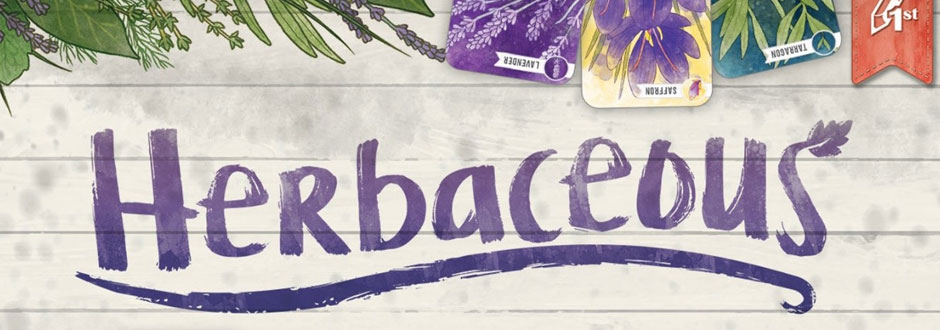
Herbaceous (The Card Game)
Awards
Rating
-
Artwork
-
Complexity
-
Replayability
-
Player Interaction
-
Component Quality
You Might Like
- Easy to lean, set up and teach.
- Great gateway game.
- Its fun.
- Solo Rules included.
Might Not Like
- The luck elements will not appeal to all.
- Sadly the theme will put people off when in reality
- it shouldnt.
Related Products
Description
In Herbaceous players are trying to grow and then store a variety of different herbs in order to gain points. There is a community garden which is accessible to all players, as well as a player’s private garden from which other players can not take herbs.
Each turn a player takes two cards, one at a time from the top of the deck. When they draw the first card they have to decide whether they want to place it in the community garden, for any player to use, or whether they want to place it in their private garden. The second card they draw must go in the area their first card did not.
After the first few turns, when there are more cards in play, at the start of their turn a player can decide to pot herbs in one of their containers. Each container has different rules for the type of herb which can be planted there. One container must have herbs all of the same type planted in there whilst another must have herbs of different types planted. A third container requires pairs of different herbs to be planted. The fourth container can have three of any herb in, but is the only place where special herbs, worth bonus points, can be placed.
Players can pot herbs from the community garden, their private garden or a combination of the two. But once the herbs have been potted they are stored underneath the container and cannot be used by the other players. There is therefore an element of “push your luck” in Herbaceous as players try to wait for the biggest collection of herbs possible, whilst making sure they take them before other players get there.
At the end of the game players add up points from their containers and any special herbs. The player with the most points wins.
Player Count: 1 - 4
Time: 15-20 minutes
Age: 8+

It’s not very often I play a game that is easy to learn and play but is great fun through multiple plays. Splendor and DeathBot Derby are two that spring to mind when I played Herbaceous for the first time.
Funded on Kickstarter for just shy of $60,000 this game, designed by Steve Finn and Edurado Baraf, is really one of the best gateway and filler games I have played. The art (by Beth Sobel) is great and Keith Matejka has also created solo rules for any of you solo gamers out there.
Herbaceous – The Game
In this simple card game the idea is you plant various herbs in different containers to gain points. Potting the best collection of herbs in a container nets you bigger scores. The containers all have different sets of cards allowed to be planted there making it essential you pot plants at the ideal time. This adds a push your luck mechanic to the set collection.
The different pots are:
- Large Pot – This allows identical herb cards to be planted here.
- Wooden Planter – This allows only different herbs to be planted.
- Small Pots – This allows pairs to be planted.
- Glass Jar – This allows any three herbs to be planted and the deck of herb cards has three special herb cards that if planted here you gain bonus points.
Each player has a private garden (your hand or area in front of you) and all four of the pots above. There is also the area called the community garden – which is in the centre of the table.
- Private Garden – The area where you can store cards ready to be planted and can not be used by other players.
- Community Garden – The area where any player can make use of the herbs.
On each player’s turn they get to draw one card and decide where to put it, private or community garden, then you draw another card and place that in the opposite garden. On your next turn you can choose to plant the herbs in your garden along with any in the communal garden as long as they match the pots and/or then draw cards in the same way you did on your first turn.
That’s it, simple, quick and easy but so much fun.
Final Thoughts
Herbaceous is a quick 10/20-minute game of push your luck (when do you plant). It’s so much fun, when you plant and the person who’s turn it is next was waiting for the same card is funny and adds great player interaction.
The downtime is very little as you need to be aware of what cards are being drawn and what your opponent’s cards are. The cards are of great quality and the art is colourful and pleasant. All in all this is a great filler game that will get played again and again.
Zatu Score
Rating
- Artwork
- Complexity
- Replayability
- Player Interaction
- Component Quality
You might like
- Easy to lean, set up and teach.
- Great gateway game.
- Its fun.
- Solo Rules included.
Might not like
- The luck elements will not appeal to all.
- Sadly the theme will put people off when in reality
- it shouldnt.


